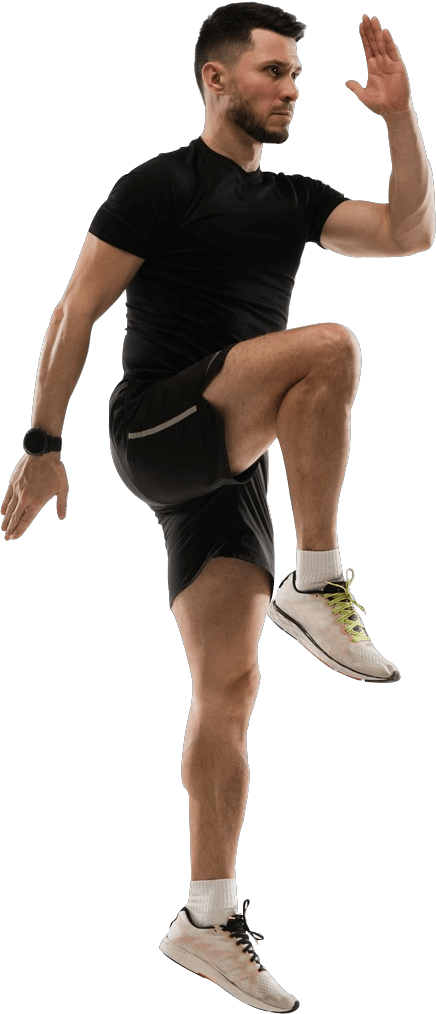You have had a loose chest or even man boobs and have felt embarrassment your whole life?
Do you want to build a chest that looks good even in a slim-fit shirt with a light colour?
You finally hit the gym but are unaware of how to build your chest using only barbell chest exercises.
Well, worry not we got you. If you perform all these exercises in the way we tell you, you surely will get a good upper, lower and middle chest. Let’s get started!
Why you should trust us
When it comes to fitness advice, trust is paramount. We understand the importance of earning your confidence.
Our team of dedicated fitness experts, commitment to accuracy, and reliable information are just a few reasons why you can rely on us.
Moreover, our team consists of certified trainers, exercise physiologists, and experienced athletes who have a deep understanding of strength training, specifically barbell chest exercises.
With their expertise and 6 years of experience(I myself have been lifting for 6 years), we provide carefully curated content that has been thoroughly researched and tested. Rest assured, the information we offer is accurate, safe, and effective.
Additionally, by staying up-to-date with the latest studies and findings in exercise science, we present information that is based on reliable and current knowledge.
Furthermore, our goal is to provide you with the most accurate and trustworthy guidance for your barbell chest workouts.
We don’t just rely on theoretical knowledge; our team members personally engage in strength training and have hands-on experience with all types of workouts including barbell chest workouts.
We recommend these exercises after trying about 53+ different movements
7 best barbell chest exercises
Here is a list of our shortlisted 7 best barbell chest exercises
- Barbell Bench Press-The best exercise for chest
- Barbell Incline Bench Press-The best exercise for upper chest
- Barbell Decline Bench Press
- Barbell Floor Press
- Barbell Push-Up
- Barbell pullover
- Barbell feet elevated press
A step-by-step guide to the best barbell chest exercises
How to do the Bench press -My favourite chest exercise
The primary muscles targeted are the pectoralis major (chest muscles), along with secondary involvement of the anterior deltoids (front shoulders) and triceps.
1.Place the barbell on the rack at a height that allows you to unrack it comfortably while lying on the bench.
Ensure that the barbell is evenly loaded with the desired weight plates.
2.Sit on the bench with your feet flat on the floor and knees pointing out, ensuring a stable base.
Lie back and position yourself in the centre of the bench, with your eyes aligned directly under the barbell.
For positioning it’s very important that you have a slight arch in the back while lying which means your back should be squeezed together. Here is what I am talking about
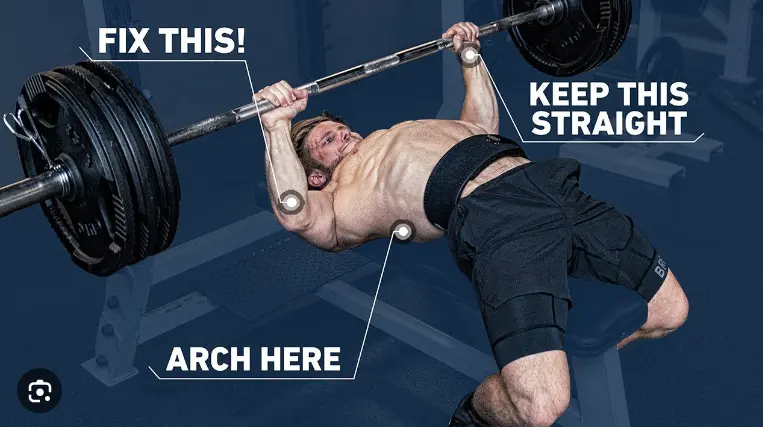
3. Reach up and grip the barbell with your hands slightly wider than shoulder-width apart.
Your palms should be facing forward, and your grip should be firm and secure. Wrapping your thumbs around the bar is recommended for safety.
4. Take a deep breath, engage your core, and lift the barbell off the rack by straightening your arms. Maintain control and ensure that the barbell is directly above your chest.
5. Slowly and under control, lower the barbell towards your lower chest while maintaining a slight arch in your lower back.
Keep your elbows at a 45-degree angle (crucial factor)from your body.
What this means is that your elbows shouldn’t flare out at exactly 90 degrees from your body as this risks serious shoulder injury
6. Once the barbell touches your chest or hovers slightly above it, hold this pose for about 1 to 2 s so that muscle is under more tension, drive your feet into the ground, and push the barbell back up to the starting position.
Exhale as you exert force during the pressing phase.
Pro tip:
1)Don’t move the barbell straight up and down instead move in a curved path. Here’s what I am talking about
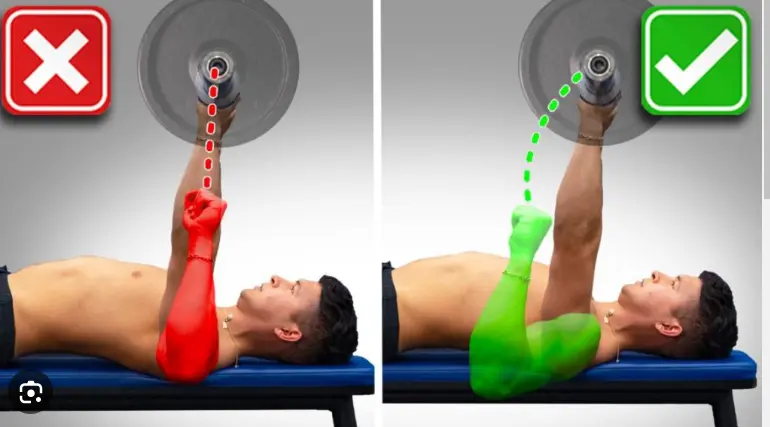
2)Start with a barbell without weights to get proper form and technique and then you can progressively overload.
3)Make sure your shoulders are minimally involved during the exercise
You don’t wanna get confused about what length barbell you need, Do you? Well, we got you covered in this detailed article:what length barbell do you need
Related: the proper way to train glutes
How to do the Incline bench press-My second favourite chest exercise
This exercise primarily targets the upper portion of the pectoralis major (upper chest), with secondary involvement of the anterior deltoids and triceps.
This is my favourite upper chest exercise.
1.Place the barbell on the rack at a height that allows you to unrack it comfortably while lying on the bench.
Ensure that the barbell is evenly loaded with the desired weight plates.
2.Sit on the bench with your feet flat on the floor and knees pointing out, ensuring a stable base.
Lie back and position yourself in the centre of the bench, with your eyes aligned directly under the barbell.
For positioning it’s crucial that you have a slight arch in the back while lying which means your back should be squeezed together. Here is what I am talking about
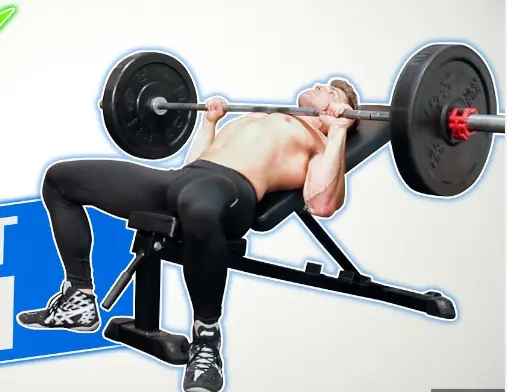
3. Reach up and grip the barbell with your hands slightly wider than shoulder-width apart.
Your palms should be facing forward, and your grip should be firm and secure. Wrapping your thumbs around the bar is recommended for safety.
4. Take a deep breath, engage your core, and lift the barbell off the rack by straightening your arms. Maintain control and ensure that the barbell is directly above your chest.
5. Slowly and under control, lower the barbell towards your middle chest while maintaining a slight arch in your lower back.
Keep your elbows at a 45-degree angle (crucial factor)from your body.
What this means is that your elbows shouldn’t flare out at exactly 90 degrees from your body as this risks serious shoulder injury
6. Once the barbell touches your chest or hovers slightly above it, hold this pose for about 1 to 2 s so that muscle is under more tension , drive your feet into the ground, and push the barbell back up to the starting position.
Exhale as you exert force during the pressing phase.
Pro tips:1)Don’t move the barbell straight up and down instead move in a curved path. Here’s what I am talking about
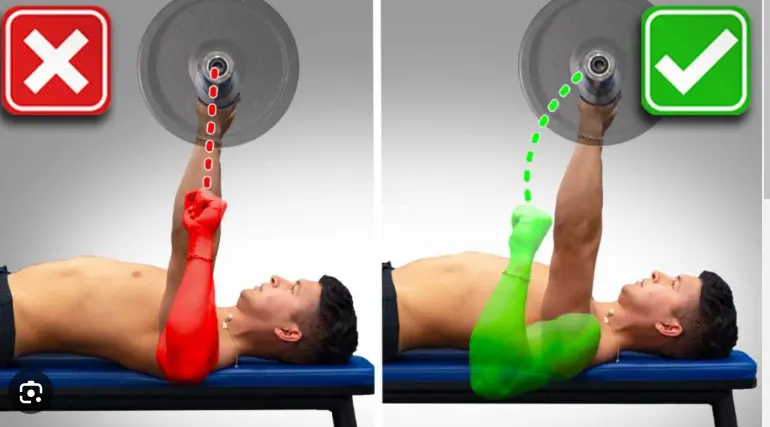
2)Start with a barbell without weights to get proper form and technique and then you can progressively overload.
3)Make sure your shoulders are minimally involved during the exercise
How to do the Barbell Decline Bench Press
The focus of this exercise is on the lower portion of the pectoralis major (lower chest), along with secondary involvement of the anterior deltoids and triceps.
1.Adjust the decline bench to your desired angle, typically between 15 to 30 degrees. Ensure that the barbell is evenly loaded with the appropriate weight plates.
2.Sit on the decline bench with your feet securely placed under the foot pads or anchored firmly on the ground.
Lie back and position yourself so that your head is lower than your hips, with your eyes aligned directly under the barbell.
3. Reach up and grip the barbell with your hands slightly wider than shoulder-width apart.
Your palms should be facing forward, and your grip should be firm and secure.
4. Take a deep breath, engage your core, and lift the barbell off the rack by straightening your arms.
Maintain control and ensure that the barbell is directly above your chest.
5. Slowly and under control, lower the barbell towards your lower chest or midsection while maintaining a slight arch in your lower back.
Keep your elbows at a 45-degree angle from your body.
6. Once the barbell touches your chest or hovers slightly above it, hold it for 1-2s, drive your feet into the ground and push the barbell back up to the starting position.
Pro tips:
1)Don’t move the barbell straight up and down instead move in a curved path. Here’s what I am talking about
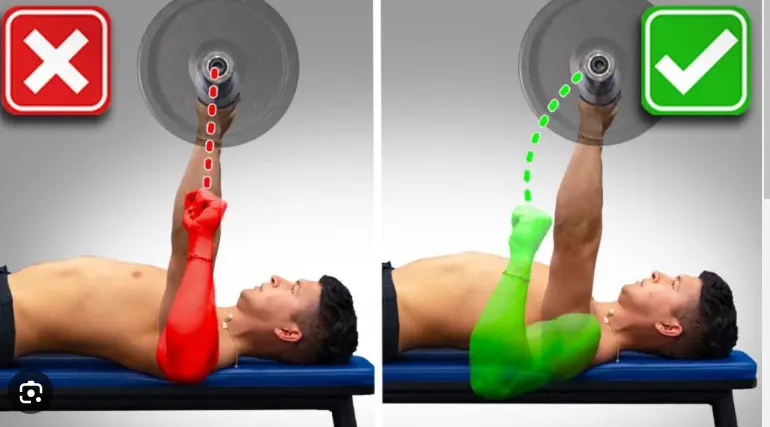
2)Start with a barbell without weights to get proper form and technique and then you can progressively overload.
3)Make sure your shoulders are minimally involved during the exercise
How to do the Barbell Floor press
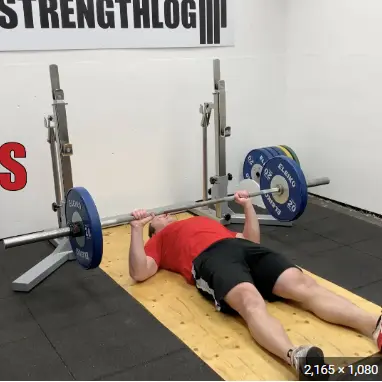
This exercise primarily targets the pectoralis major, triceps, and anterior deltoids. The range of motion is limited compared to a regular bench press, which emphasizes triceps strength.
1.Place a barbell on the floor or on a weightlifting bench. Ensure that the barbell is evenly loaded with the desired weight plates.
2. Position yourself on the floor directly under the barbell. Lie down on your back with your knees and feet straight.
Your head, upper back, and hips should maintain contact with the ground throughout the exercise.
3. Reach up and grip the barbell with your hands slightly wider than shoulder-width apart.
Your palms should be facing forward, and your grip should be firm and secure.
4. Position yourself so that the barbell is directly above your chest. Ensure that your elbows are at a 45-degree angle from your body, creating a slight bend.
5. Take a deep breath, engage your core, and lift the barbell off the ground or bench by straightening your arms.
Maintain control and keep the barbell directly above your chest.
Slowly and under control, lower the barbell towards your middle to upper chest while maintaining a slight arch in your lower back. Again Keep your elbows at a 45-degree angle from your body.
6. Once the barbell touches your chest or hovers slightly above it, drive your feet into the ground, engage your chest, shoulders, and triceps, and push the barbell back up to the starting position.
Exhale as you exert force during the pressing phase.
Using barbells so frequently, you might wanna know how to clean your barbell
How to do the Barbell pushup
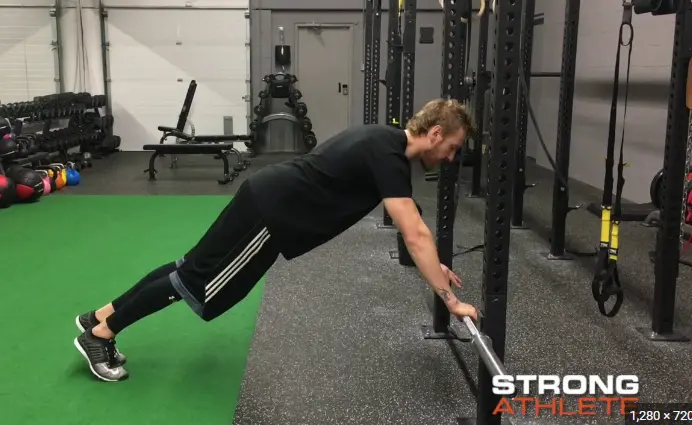
The primary muscles targeted are the pectoralis major, triceps, and anterior deltoids. Additionally, the core muscles, serratus anterior, and various stabilizer muscles are engaged.
1.Place a barbell on the floor or a rack and load it with the desired amount of weight.
Your hands should be slightly wider than shoulder-width apart, and your grip should be slightly pronated (palms facing down).
2. Get into a push-up position with your hands on the barbell. Your body should be in a straight line from your head to your heels.
Moreover, your core should be engaged, and your abs should be tight.
3. Slowly lower your body down until your chest touches the barbell. Make sure to keep your body in a straight line and your core engaged.
4. Push yourself back up. Use your chest and triceps to push yourself back up to the starting position.
How to do the Barbell pullover-My third favourite barbell chest exercise
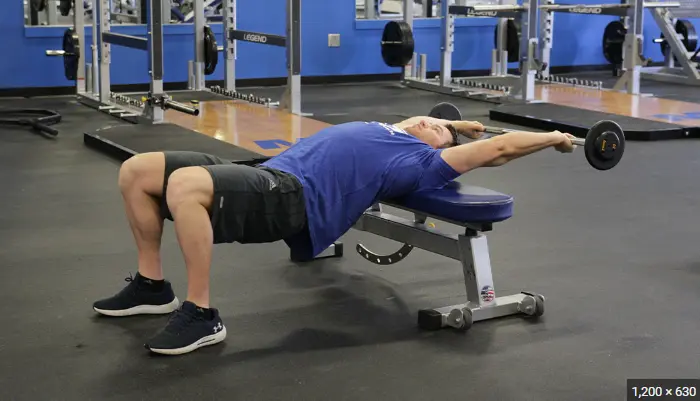
This exercise targets the pectoralis major, primarily the upper fibres. It also engages the latissimus dorsi (back muscles), triceps, and serratus anterior.
Speaking of back muscles you might wanna see an in-detail guide to best barbell back exercises
1.Place a barbell across a bench or stability ball. Ensure that the barbell is securely positioned and evenly loaded with the desired weight plates.
2. Position yourself with your upper back and head resting on the bench and your feet placed firmly on the ground.
Keep your knees bent and maintain a stable base.
3. Reach up and grip the barbell with an overhand grip (palms facing down) that is slightly wider than shoulder-width apart.
Make sure your grip is secure and comfortable.
4. Hold the barbell directly over your chest with your arms fully extended. This will be your starting position.
5. Slowly and under control, lower the barbell behind your head while keeping your arms as straight as possible.
Maintain a slight bend in your elbows to avoid excessive strain on your shoulder joints.
6. As you lower the barbell, focus on engaging your chest muscles and maintaining stability in your core. You should feel a stretch in your chest and a slight tension in your lats.
7. Lift the barbell back to the starting position by bringing it back over your chest, using a controlled and deliberate motion.
Keep your core engaged and avoid excessive swinging or arching of your back.
Pro tip:
This exercise can be a bit challenging so you can go for a low weight
Make sure all your equipment is clean as a day!
How to do the Barbell Feet Elevated Press
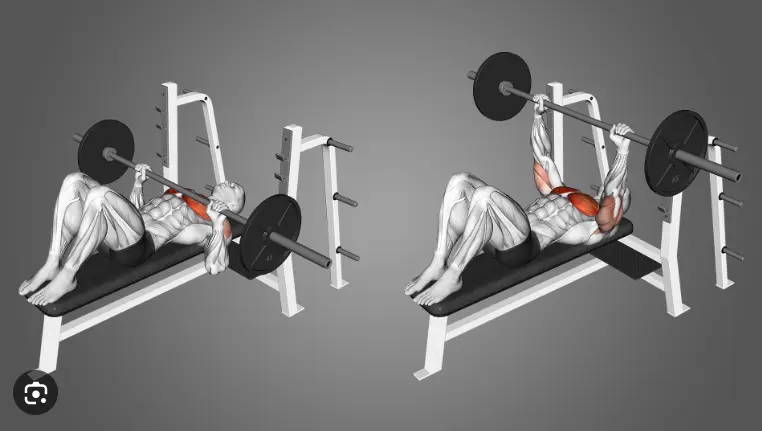
This exercise targets the entire pectoralis major, with a greater emphasis on the upper chest. It also engages the anterior deltoids, triceps, and core muscles.
1. Place a bench or sturdy platform in front of a squat rack or power rack.
Position the barbell on the rack at a height that allows you to unrack it comfortably while standing.
2 Adjust the height of the bench or platform so that when your feet are placed on it, your body is in a declined position.
The exact height will depend on your comfort and desired level of difficulty.
3.Sit on the edge of the bench or platform with your feet elevated on it. Your knees should be bent and your feet should be firmly placed on the platform, creating a decline angle for your body.
4. Reach up and grip the barbell with your hands slightly wider than shoulder-width apart.
Your palms should be facing forward, and your grip should be firm and secure.
5. Take a deep breath, engage your core, and lift the barbell off the rack by straightening your arms.
Maintain control and ensure that the barbell is directly above your chest.
6. Slowly and under control, lower the barbell towards your mid to upper chest while maintaining a slight arch in your lower back.
Keep your elbows at a 45-degree angle(important) from your body.
7. Once the barbell touches your chest or hovers slightly above it, drive your feet into the platform, engage your chest, shoulders, and triceps, and push the barbell back up to the starting position.
Exhale as you exert force during the pressing phase.
The perfect barbell chest workout
Here are 4 barbell chest exercises that are mandatory in your workout program:
4×8 flat bench press
4×8 incline bench press
4×8 decline bench press
3×10 barbell feet elevated press
These 4 barbell exercises for chest are recommended by us and you might wanna add some cable exercises into your chest workout too.
Golden tip:
You should train each set with 1-3 reps left till failure.
Don’t over-train or undertrain as overtraining will lead to fatigue and a drop in the quality of the remaining sets and undertraining will not cause hypertrophy needed for a bigger muscle.
FAQS
Question 1: Does barbell chest exercises increase chest size?
Answer: Yes, barbell exercises can contribute to increasing chest size
. Barbell exercises like the bench press, incline bench press, and decline bench press primarily target the chest muscles (pectoralis major) and can stimulate muscle growth when performed with proper form and progressive overload.
Question 2: How do I shape my chest?
Answer: To shape your chest, it’s important to incorporate a combination of exercises that target different areas of the chest.
Barbell chest exercises like bench press variations (flat, incline, decline), dumbbell flyes, cable crossovers, and push-ups can help develop and shape the chest muscles.
Additionally, focusing on proper nutrition and maintaining a balanced training routine are important factors in achieving a well-shaped chest.
Question 3: How to get a big chest?
Answer: To get a big chest, it’s essential to prioritize chest-focused exercises and incorporate progressive overload.
Barbell chest exercises like bench press variations, dumbbell press, and chest flyes are effective in building chest size.
Gradually increasing the weight, performing an appropriate number of sets and repetitions, and allowing adequate rest and recovery are key to developing a bigger chest.
Question 4: Why is my chest not growing?
Answer: Several factors could contribute to a lack of chest growth. These include insufficient training volume or intensity, poor exercise selection or form, inadequate nutrition, lack of progressive overload, poor sleep, high level of stress or inadequate recovery.
Question 5: Why is my chest so hard to build?
Answer: Building the chest can be challenging for some individuals due to various factors. Genetics, muscle imbalances, improper exercise technique, inadequate training volume or intensity, lack of progressive overload, and insufficient nutrition are common reasons why building the chest might be difficult.
Addressing these factors by incorporating a well-rounded training program, focusing on proper form, progressively increasing weights, optimizing nutrition, and ensuring adequate rest can help overcome challenges and facilitate chest muscle development.
Conclusion
Now you know all the best barbell chest exercises there are.
If these exercises are performed in the way we told you, then surely you are going to have a chest that you are confident about.
Give the chest as much importance as your biceps and HIT THE GYM!
About me

Hi, I am Abdullah, a guy whose passion for fitness led to his bachelor’s degree in exercise science, for me what started as a personal fascination soon transformed into a professional career. Over the last six years, I have had the privilege of guiding and supporting numerous individuals on their own fitness journeys. Whether they were beginners taking their first steps into the gym or seasoned athletes aiming to break their personal records, I have been there every step of the way, providing personalized training programs tailored to their unique needs and goals.

